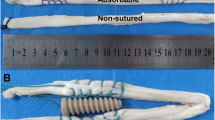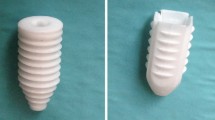Abstract
Purpose
In anterior cruciate ligament reconstruction with looped soft-tissue grafts, an interference screw is frequently used for tibial fixation. This study compared three alternatives thought to improve the initial mechanical properties of direct bioabsorbable interference screw fixation: suturing the graft to close the loop, adding a supplementary staple, or increasing the oversize of the screw diameter relative to the bone tunnel from 1 to 2 mm.
Methods
Twenty-eight porcine tibiae and porcine flexor digitorum profundus tendons were randomized into four testing groups: a base fixation using 10-mm-diameter screw with open-looped graft, base fixation supplemented by an extracortical staple, base fixation but closing the looped graft by suturing its ends, and base fixation but using an 11-mm screw. Graft and bone tunnel diameters were 9 mm in all specimens. Constructs were subjected to cyclic tensile load and finally pulled to failure to determine their structural properties.
Results
The main mode of failure in all groups was pull-out of tendon strands after slippage past the screw. The sutured graft group displayed significantly lower residual displacement (mean value reduction: 47–67 %) and higher yield load (mean value increase: 38–54 %) than any alternative tested. No other statistical differences were found.
Conclusions
Suturing a soft-tissue graft to form a closed loop enhanced the initial mechanical properties of tibial fixation with a bioabsorbable interference screw in anterior cruciate ligament reconstructions using a porcine model, and thus, this may be an efficient means to help in reducing post-operative laxity and early clinical failure. No mechanical improvement was observed for an open-looped tendon graft by adding an extracortical staple to supplement the screw fixation or by increasing the oversize of the screw to tunnel diameter from 1 to 2 mm.




Similar content being viewed by others
References
Adam F, Pape D, Schiel K, Steimer O, Kohn D, Rupp S (2004) Biomechanical properties of patellar and hamstring graft tibial fixate on techniques in anterior cruciate ligament reconstruction: experimental study with roentgen stereometric analysis. Am J Sports Med 32:71–78
Brand JC Jr, Pienkowski D, Steenlage E, Hamilton D, Johnson DL, Caborn DNM (2000) Interference screw fixation strength of a quadrupled hamstring tendon graft is directly related to bone mineral density and insertion torque. Am J Sports Med 28:705–710
Bravman J, Ishak C, Gelber J, Namkoong S, Jazrawi L, Kummer FJ (2006) The interaction between the whipstitch sutures of multi-strand ACL grafts and interference screw fixation. Bull Hosp Jt Dis 63:156–157
Caborn DNM, Nyland J, Selby J, Tetik O (2003) Biomechanical testing of hamstring graft tibial tunnel fixation with bioabsorbable interference screws. Arthroscopy 19:991–996
Chang HC, Nyland J, Nawab A, Burden R, Caborn DN (2005) Biomechanical comparison of the bioabsorbable RetroScrew system, BioScrew XtraLok with stress equalization tensioner, and 35-mm Delta Screws for tibialis anterior graft-tibial tunnel fixation in porcine tibiae. Am J Sports Med 33:1057–1064
Charlick DA, Caborn DN (2000) Alternative soft tissue graft preparation technique for cruciate ligament reconstruction. Arthroscopy 6:E20
Espejo-Baena A, Ezquerro F, Pérez de la Blanca A, Serrano-Fernández J, Nadal F, Montañez-Heredia E (2006) Comparison of initial mechanical properties of 4 hamstring graft femoral fixation systems using nonpermanent hardware for anterior cruciate ligament reconstruction: an in vitro animal study. Arthroscopy 22:433–440
Giurea M, Zorilla P, Amis AA, Aichroth P (1999) Comparative pull-out and cyclic-loading strength tests of anchorage of hamstring tendon grafts in anterior cruciate ligament reconstruction. Am J Sports Med 27:621–625
Halewood C, Hirschmann MT, Newman S, Hleihil J, Chaimski G, Amis AA (2011) The fixation strength of a novel ACL soft-tissue graft fixation device compared with conventional interference screws: a biomechanical study in vitro. Knee Surg Sports Traumatol Arthrosc 19:559–567
Hamner DL, Brown CH Jr, Steiner ME, Hecker AT, Hayes WC (1999) Hamstring tendon grafts for reconstruction of the anterior cruciate ligament: biomechanical evaluation of the use of multiple strands and tensioning techniques. J Bone Joint Surg Am 81:549–557
Harvey A, Thomas NP, Amis AA (2005) Fixation of the graft in reconstruction of the anterior cruciate ligament. J Bone Joint Surg Br 87-B:593–603
Herrera A, Martínez F, Iglesias D, Cegoñino J, Ibarz E, Gracia L (2010) Fixation strength of biocomposite wedge interference screw in ACL reconstruction: effect of screw length and tunnel/screw ratio. A controlled laboratory study. BMC Musculoskelet Disord 11:139–146
Hill PF, Russell VJ, Salmon LJ, Pinczewski LA (2005) The influence of supplementary tibial fixation on laxity measurements after anterior cruciate ligament reconstruction with hamstring tendons in female patients. Am J Sports Med 33:94–101
Johnson D (2005) Anterior cruciate reconstruction using hamstring graft fixed with bioscrews and augmented with the endopearl. Tech Orthop 20:264–271
Kamelger FS, Onder U, Schmoelz W, Tecklenburg K, Arora R, Fink C (2009) Suspensory fixation of grafts in anterior cruciate ligament reconstruction: a biomechanical comparison of 3 implants. Arthroscopy 25:767–776
Kitamura N, Yasuda K, Yamanaka M, Tohyama H (2003) Biomechanical comparisons of three posterior cruciate ligament reconstruction procedures with load-controlled and displacement-controlled cyclic tests. Am J Sports Med 31:907–914
Kousa P, Järvinen TLN, Vihavainen M, Kannus P, Järvinen M (2003) The fixation strength of six hamstring tendon graft fixation devices in anterior cruciate ligament reconstruction: Part II: tibial site. Am J Sports Med 31:182–188
Krackow KA, Thomas SC, Jones LC (1988) Ligament-tendon fixation: analysis of a new stitch and comparison with standard techniques. Orthopedics 11:909–917
Kudo T, Tohyama H, Minami A, Yasuda K (2005) The effect of cyclic loading on the biomechanical characteristics of the femur-graft-tibia complex after anterior cruciate ligament reconstruction using Bone Mulch screw/WasherLoc fixation. Clin Biomech 20:414–420
Lahav A, Burks RT (2005) Evaluation of the failed ACL reconstruction. Sports Med Arthrosc Rev 13:8–16
Lee JJ, Otarodifard K, Jun BJ, McGarry MH, Hatch GF III, Lee TQ (2011) Is supplementary fixation necessary in anterior cruciate ligament reconstructions? Am J Sports Med 39:360
Lim CT, Tan K, Chuan AK (2009) Clinical stability and outcome of supplementing tibial fixation with a staple for ACL reconstruction using hamstring tendons. Curr Orthop Pract 20:660–664
Magen HE, Howell SM, Hull ML (1999) Structural properties of six tibial fixation methods for anterior cruciate ligament soft tissue grafts. Am J Sports Med 27:35–43
Meuffels DE, Docter PT, van Dongen RA, Kleinrensink G, Verhaar JAN, Reijman M (2010) Stiffer fixation of the tibial double-tunnel anterior cruciate ligament complex versus the single tunnel: a biomechanical study. Arthroscopy 26:S35–S40
Micucci CJ, Frank DA, Kompel J, Muffly M, Demeo PJ, Altman GT (2010) The effect of interference screw diameter on fixation of soft-tissue grafts in anterior cruciate ligament reconstruction. Arthroscopy 26:1105–1110
Miyata K, Yasuda K, Kondo E, Nakano H, Kimura S, Hara N (2000) Biomechanical comparisons of anterior cruciate ligament: reconstruction procedures with flexor tendon graft. J Orthop Sci 5:585–592
Monaco E, Labianca L, Speranza A, Agro AM, Camillieri G, D’arrigo C, Ferretti A (2010) Biomechanical evaluation of different anterior cruciate ligament fixation techniques for hamstring graft. J Orthop Sci 15:125–131
Morris MW, Williams JL, Thake AJ, Lang Y, Brown JN (2004) Optimal screw diameter for interference fixation in a bone tunnel: a porcine model. Knee Surg Sports Traumatol Arthrosc 12:486–489
Nagarkatti DG, McKeon BP, Donahue BS, Fulkerson JP (2001) Mechanical evaluation of a soft tissue interference screw in free tendon anterior cruciate ligament graft fixation. Am J Sports Med 29:67–71
Namkoong S, Heywood CS, Bravman JT, Ieyasa K, Kummer FJ, Meislin RJ (2006) The effect of interference screw diameter on soft tissue graft fixation. Bull Hosp Jt Dis 63:153–155
Nurmi JT, Sievänen H, Kannus P, Järvinen M, Järvinen TLN (2004) Porcine tibia is a poor substitute for human cadaver tibia for evaluating interference screw fixation. Am J Sports Med 32:765–771
Roy S, Fernhout M, Stanley R, McGee M, Carbone T, Field JR, Dobson P (2010) Tibial interference screw fixation in anterior cruciate ligament reconstruction with and without autograft bone augmentation. Arthroscopy 26:949–956
Rupp S, Seil R, Schneider A, Kohn DM (1999) Ligament graft initial fixation strength using biodegradable interference screws. J Biomed Mater Res 48:70–74
Scheffler S, Sudkamp N, Gockenjan A, Hoffmann R, Weiler A (2002) Biomechanical comparison of hamstring and patellar tendon graft anterior cruciate ligament reconstruction techniques: the impact of fixation level and fixation method under cyclic loading. Arthroscopy 18:304–315
Trump M, Palathinkal DM, Beaupre L, Otto D, Leung P, Amirfazli A (2011) In vitro biomechanical testing of anterior cruciate ligament reconstruction: Traditional versus physiologically relevant load analysis. Knee 18:193–201
Walsh MP, Wijdicks CA, Armitage BM, Westerhaus BD, Parker JB, Laprade RF (2009) The 1:1 versus the 2:2 tunnel-drilling technique: optimization of fixation strength and stiffness in an all-inside double-bundle anterior cruciate ligament reconstruction—a biomechanical study. Am J Sports Med 37:1539–1547
Weiler A, Hoffmann RFG, Siepe CJ, Kolbeck SF, Südkamp NP (2000) The influence of screw geometry on hamstring tendon interference fit fixation. Am J Sports Med 28:356–359
Wijdicks CA, Brand EJ, Nuckley DJ, Johansen S, LaPrade RF, Engebretsen L (2010) Biomechanical evaluation of a medial knee reconstruction with comparison of bioabsorbable interference screw constructs and optimization with a cortical button. Knee Surg Sports Traumatol Arthrosc 18:1532–1541
Zantop T, Weimann A, Schmidtko R, Herbort M, Raschke MJ, Petersen W (2006) Graft laceration and pullout strength of soft-tissue anterior cruciate ligament reconstruction: in vitro study comparing titanium, poly-d, l-lactide, and poly-d, l-lactide-tricalcium phosphate screws. Arthroscopy 22:1204–1210
Conflict of interest
The authors declare that they have no conflict of interest.
Author information
Authors and Affiliations
Corresponding author
Rights and permissions
About this article
Cite this article
Prado, M., Martín-Castilla, B., Espejo-Reina, A. et al. Close-looped graft suturing improves mechanical properties of interference screw fixation in ACL reconstruction. Knee Surg Sports Traumatol Arthrosc 21, 476–484 (2013). https://doi.org/10.1007/s00167-012-1975-9
Received:
Accepted:
Published:
Issue Date:
DOI: https://doi.org/10.1007/s00167-012-1975-9




